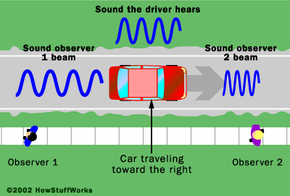Where the Big Bang Theory Came From
The big bang theory is the result of two different approaches to studying the universe: astronomy and cosmology. Astronomers use instruments to observe stars and other celestial bodies. Cosmologists study the astrophysical properties of the universe.
In the 1800s, astronomers began to experiment with tools called spectroscopes (also known as spectrographs). A spectroscope is a device that divides light into a spectrum of its component wavelengths. Spectroscopes showed that the light from a specific material, such as a glowing tube of hydrogen, always produced the same distribution of wavelengths unique to that material. It became clear that by looking at the wavelength distribution from a spectrograph, you could figure out what kind of elements were in a light source.
Advertisement
Meanwhile, Austrian physicist Christian Doppler discovered that the frequency of a sound wave depended upon the relative position of the source of the sound. As a noisy object approaches you, the sound waves it generates compress. This changes the frequency of the sound, and so you perceive the sound as a different pitch. When the object moves away from you, the sound waves stretch and the pitch goes down. It's called the Doppler effect.
Light travels in waves too, and astronomers discovered that some stars had more light falling into the red side of the spectrum than they expected. They theorized that this meant the stars were moving away from Earth. As the stars move away, the wavelengths from the light they emit stretch. They shift to the red end of the spectrum because that end has longer wavelengths. Cosmologists call this phenomenon the redshift. A star's redshift is an indication of how quickly it is moving away from Earth. The further toward the red end of the spectrum the light shifts, the faster the star is moving away.
In the 1920s, an astronomer named Edwin Hubble noticed something interesting. The velocity of a star appeared to be proportional to its distance from the Earth. In other words, the further away a star was from Earth, the faster it appeared to move away from us. Hubble theorized that this meant the universe itself was expanding.
Hubble's discovery led to a lengthy debate that still rages today: what exactly is the relation between a distant celestial body's velocity and its distance from the observer? Cosmologists call this relationship the Hubble constant, but no one agrees on what that relationship is. Hubble theorized that it was 464 kilometers (km) per second (sec) per megaparsec (Mpc). A megaparsec is a unit of distance equal to more than 3.08 x 1022 meters (or 1.9 x 1019 miles).
It turns out Hubble overestimated this number. That's because in Hubble's time, astronomical instruments weren't sensitive enough to measure the distance between the Earth and celestial bodies with accuracy. As instruments improved, scientists refined the Hubble constant, but debate over the actual value of the Hubble constant rages on.
What does all this have to do with the big bang theory? Keep reading to find out.
